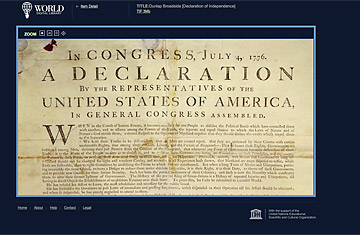
The World Digital Library
Supported by the United Nations Educational, Scientific and Cultural Organization (UNESCO) and U.S. Library of Congress
www.wdl.org
The Gist:
Four years ago, U.S. Librarian of Congress James H. Billington proposed the establishment of an online forum that would allow libraries and museums across the globe to share valuable cultural and educational data with anyone who had access to the Internet. On April 21, UNESCO and the Library of Congress officially unveiled its $60 million joint effort to do just that. With funding from sources including King Abdullah University in Saudi Arabia and the Carnegie Corporation in New York, more than two dozen institutions contributed content that covers nearly 200 countries. The result is the World Digital Library: a compendium of some 1,200 high-resolution digitized files that allows users to zoom in on ancient documents and archival photographs. The Library also contains a sophisticated search tool that allows users to browse by keywords, time period, place, type of item and the institution which contributed it. Finally, it provides descriptions of all materials in seven languages (Arabic, Chinese, English, French, Russian, and Spanish — the official languages of the United Nations), though many of the documents, books and other components appear in their original languages.
Highlight Reel:
Books, Journals, Documents: The database contains some old favorites, like the U.S. Declaration of Independence and Bill of Rights as well the constitutions of numerous countries. There are also gems like the first printed edition of the 16th-century Japanese novel The Tale of Genji, and a journal kept by a Venetian scholar who accompanied Ferdinand Magellan on his voyage around the world. If English is more your speed, try the translation of a French voyager's tour of the Indian Ocean — maybe a safer trip than it is today.
Photographs: Photography is the strong suit of this collection with images ranging from a photo-panoramic view of Constantinople to a photo of George H.W. Bush as a senior on the Yale baseball team meeting Babe Ruth in 1948 to a photo of a traditional Chinese bride.
Audio/Video: Multimedia options are a little bit more difficult to come by, but some impressive ones stand out including one of the earliest recordings of "Amazing Grace" and the Marseillaise. For visual stimulation, try a late 19th-century short film of a Holy Week procession in Spain from the great Lumière brothers. (See TIME's pictures of modern-day Holy Week)
The Lowdown
While the artifacts themselves are well-presented and engrossing, it's hard to see how this promising collection of primary sources can avoid competing with the likes of Google and Wikipedia for readers who don't need to read Genji in the original Japanese. A similar Library of Congress archive was established back in the 90s, making a big splash at first but eventually falling to the wayside. Still, the World Digital Library has been mostly created with students in mind, who are most likely to find its mix of primary sources useful — so long as they actually know it exists. For most of people, though, the Digital Library will likely be more of a thing to admire at leisure, when maybe visiting the museum or institution that houses a rare manuscript would be more time-consuming than clicking on an image and zooming to the parts that seem most interesting. Here's to hoping digitizing history and artifacts doesn't do what the advent of new media has done to print.
The Verdict: Skim
